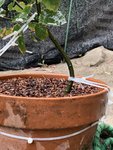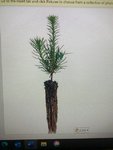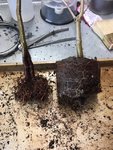I have purchased several species of deciduous saplings this spring and some beech saplings last year. There is a problem that seems to be more and more consistent. The trees are started in tubes, and then allowed to stay in the tubes way to long. Then you get a knot of twisted, very tight roots, that are headed straight down with feeder roots at the bottom. I'm not sure of the time frame here, but it looks like some of the younger tube grown that were is the tubes to long have been re-planted, but the roots were left as is so you just get a bigger knot of roots all headed down verses out. In order to make this work for shallower bonsai pots, the roots have to be cut off and maybe bent outwards, but if this tube grown seedling has been allowed to grow like this for very long, the roots are fairly big in diameter and hard to get trained to grow out. Also when cutting off the downward roots for the bonsai pots, your going to loose some trees. I wish I had taken some pictures lately of the ones I received. I will ask more questions BEFORE I purchase any more saplings.
You are using an out of date browser. It may not display this or other websites correctly.
You should upgrade or use an alternative browser.
You should upgrade or use an alternative browser.
Tube grown saplings
- Thread starter August44
- Start date
Wires_Guy_wires
Imperial Masterpiece
I've been running in to the same issue, and I'm going to design a solution next week.
John P.
Chumono
You can try girdling the trunks to ground layer them. You can even use a plastic lid (think sour cream container or the like), cut a hole in the center to match the diameter of the trunk with a cut to the edge so you can place it around the trunk, and set it just below the girdle. I usually use aluminum tape over the cut so roots won’t grow through the cut.
Make sure the layer is buried with enough substrate to keep it moist.
Make sure the layer is buried with enough substrate to keep it moist.
Michael P
Omono
The simplest solution is don't buy from growers who use tube pots. Of course youi may not know this if the sapling has been repotted before you get it.
There are nursery pots designed to prevent this problem. The best known and most effective brand is Root Maker https://rootmaker.com/ These containers use root entrapment and air pruning to create a fine, well branched root system from the start, much as colanders and pond baskets do, only better.
There are nursery pots designed to prevent this problem. The best known and most effective brand is Root Maker https://rootmaker.com/ These containers use root entrapment and air pruning to create a fine, well branched root system from the start, much as colanders and pond baskets do, only better.
penumbra
Imperial Masterpiece
I have re potted dozens upon dozens of trees grown in tubes. I transplant them late winter to early spring usually prior to bud break. I take my pruners and cut the bottom half off without hesitation. I then spread out the roots and untangle them, removing thick roots with downward growth. I have never lost one. Even if I lose a little seasonal growth (which seldom happens), getting the root system in order is worth it. Depending on the species, I will also sometimes do this during the growing season.
John P.
Chumono
MrWunderful
Omono
John P.
Chumono
View attachment 305218
I like to tournaquet deciduous with a 4-11/16” electrical junction box cover with a 1/2” ko in the center. Built in plate for flat root base.
Crafty!
sorce
Nonsense Rascal
Bouncing straight off the last "layer it" thread..
Surface roots and branches should be roughly the same "age"/size.
So growing a trunk, and then restarting the top and bottom is the most consistent way to get there.
More control.
Sorce
Surface roots and branches should be roughly the same "age"/size.
So growing a trunk, and then restarting the top and bottom is the most consistent way to get there.
More control.
Sorce
Bonsai Nut
Nuttier than your average Nut
Yes, buying trees that are grown like this is a pain in the ass. It's like buying a new car and then having to rebuild it. Waste of time. Thank you Michael P for that link
The ten valley oaks I just received were all grown in tubes. I simply removed the bottom 50% of the roots (with a thick tap root) and potted up the trees in one pot... and the roots in another
We'll see if the root cuttings take, but I may end up with more trees than I started with
For those unaware or who have not dealt with this problem, here's how it all starts. The trees shown here are from an Amazon ad. I understand that tube growing is an easy way to get trees started, and a very space saving method also. The problem comes from allowing the tree to stay in the 1-1.5" tube to long, and then repotting that tree in a bigger container just like it comes out of the tube verses replanting at the right time, and spreading the roots out horizontally verses allowing them to continue their straight down venture. The downward growing roots don't just magically start growing horizonally, they continue their downward direction for he most part. It doesn't take very long for even small roots to get stiff and then it becomes difficult to change their direction without some serious, time consuming work.
As demonstrated by the two pictures of a beech seeding, it doesn't make any difference if the containers are tubes or squared ones, the results can be the same if not attended to correctly. I bought the beech seedlings for a forest planting. They were not cheap! They had been in the containers way to long and the root ball was a tight mass of interwoven roots that was difficult for me to work with. By the time I got the downward growing roots pruned back enough so they would fit into the setting, I had removed a major portion of the roots. I lost 3 out of the seven. Yes, I'm sure it was my fault, but things would have good a lot better if the grower back down the line would have done things a little differently. As MICHAEL P pointed out above , there are containers out there that will certainly help that situation, if they were just used.
Yes, I am aware that us bonsai people are asking for something that most people don't understand and could care less about.
As demonstrated by the two pictures of a beech seeding, it doesn't make any difference if the containers are tubes or squared ones, the results can be the same if not attended to correctly. I bought the beech seedlings for a forest planting. They were not cheap! They had been in the containers way to long and the root ball was a tight mass of interwoven roots that was difficult for me to work with. By the time I got the downward growing roots pruned back enough so they would fit into the setting, I had removed a major portion of the roots. I lost 3 out of the seven. Yes, I'm sure it was my fault, but things would have good a lot better if the grower back down the line would have done things a little differently. As MICHAEL P pointed out above , there are containers out there that will certainly help that situation, if they were just used.
Yes, I am aware that us bonsai people are asking for something that most people don't understand and could care less about.
Attachments
Michael P
Omono
Improperly formed root systems are actually a huge problem in the landscape industry. Typical nursery practices often produce circling roots, which become girdling roots. The problem doesn't show up until the tree has been in the ground for years, when it fails to grow or blows over in a wind storm. The owner of the tree can't figure out what went wrong, and so buys another tree to replace it. But the new tree has the same problem--built-in resale for the grower and retailer.
Future problems sometimes be prevented at planting by doing appropriate root work. But many home owners and even landscape contractors are ignorant (or lazy) and don't do what is necessary.
Future problems sometimes be prevented at planting by doing appropriate root work. But many home owners and even landscape contractors are ignorant (or lazy) and don't do what is necessary.
John P.
Chumono
Just to follow up on my ground layer recommendation ...
This is a Coast Live Oak (Quercus agrifolia). It had galls of some sort at its base, which were never going to look good. I decided to ring the bark above the galls only about a month ago or so. Moving aside about an inch of orchid seedling bark, here’s the tree yesterday:



The additional benefit will be some extra trunk flare above the layer and roots that will exit at the same plane despite the angle/movement that I’m inducing with the zip ties. I don’t recall if I placed anything under the layer to keep the roots growing horizontally, but I’ve found that they tend to grow horizontally anyway using this method. I’ll probably arrange the roots in another month or two before they lignify too much.
All to say that there are ways to correct trees that are grown for mass propagation like your Beeches.
This is a Coast Live Oak (Quercus agrifolia). It had galls of some sort at its base, which were never going to look good. I decided to ring the bark above the galls only about a month ago or so. Moving aside about an inch of orchid seedling bark, here’s the tree yesterday:



The additional benefit will be some extra trunk flare above the layer and roots that will exit at the same plane despite the angle/movement that I’m inducing with the zip ties. I don’t recall if I placed anything under the layer to keep the roots growing horizontally, but I’ve found that they tend to grow horizontally anyway using this method. I’ll probably arrange the roots in another month or two before they lignify too much.
All to say that there are ways to correct trees that are grown for mass propagation like your Beeches.
Michael P
Omono
Good use of zip ties!
John P.
Chumono
Ha—thanks. Ugly as hell, but effective! It’s nice to be able to cinch down the zip ties little by little so there’s little risk of breaking the trunk. The parts of the ties touching the tree have silicone airline tubing over the ties to prevent marring the bark. So far so good.Good use of zip ties!
I believe one of the marketing points for tubes is to develop deep root systems that are better adapted to drought/transplant shock. They also avoid some of the problems with circling roots if transplanted early enough since roots prefer going down to circling. But agree, they don't do us bonsai people any favors.
In contrast the fabric air pruning pots are almost magical..the root systems still require work to adapt to bonsai culture but they create a lot more options, tend to eliminate circling roots and heavy woody roots.
In contrast the fabric air pruning pots are almost magical..the root systems still require work to adapt to bonsai culture but they create a lot more options, tend to eliminate circling roots and heavy woody roots.
Similar threads
- Replies
- 42
- Views
- 4K




